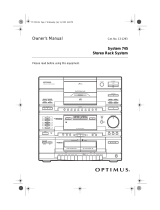Radio Shack Wireless Indoor/Outdoor Thermometer Owner's manual
- Category
- Environment thermometers
- Type
- Owner's manual
This manual is also suitable for
Radio Shack 63-1033 is a Wireless Indoor/Outdoor Thermometer with a Wireless Remote Sensor that lets you monitor the temperature indoors and out. Some of its capabilities include:
-
Temperature Monitoring: Monitor temperature both indoors and outdoors. Place the remote sensor outdoors or in another room to monitor the temperature at different locations, each using a different channel.
-
Channel Scanning: The main unit can display information for up to three remote sensors. Additional remote sensors can be purchased separately.
-
Kinetic Wave Display: Graphically displays the temperature trend using a wave-like pattern.
Radio Shack 63-1033 is a Wireless Indoor/Outdoor Thermometer with a Wireless Remote Sensor that lets you monitor the temperature indoors and out. Some of its capabilities include:
-
Temperature Monitoring: Monitor temperature both indoors and outdoors. Place the remote sensor outdoors or in another room to monitor the temperature at different locations, each using a different channel.
-
Channel Scanning: The main unit can display information for up to three remote sensors. Additional remote sensors can be purchased separately.
-
Kinetic Wave Display: Graphically displays the temperature trend using a wave-like pattern.




















-
 1
1
-
 2
2
-
 3
3
-
 4
4
-
 5
5
-
 6
6
-
 7
7
-
 8
8
-
 9
9
-
 10
10
-
 11
11
-
 12
12
-
 13
13
-
 14
14
-
 15
15
-
 16
16
-
 17
17
-
 18
18
-
 19
19
-
 20
20
Radio Shack Wireless Indoor/Outdoor Thermometer Owner's manual
- Category
- Environment thermometers
- Type
- Owner's manual
- This manual is also suitable for
Radio Shack 63-1033 is a Wireless Indoor/Outdoor Thermometer with a Wireless Remote Sensor that lets you monitor the temperature indoors and out. Some of its capabilities include:
-
Temperature Monitoring: Monitor temperature both indoors and outdoors. Place the remote sensor outdoors or in another room to monitor the temperature at different locations, each using a different channel.
-
Channel Scanning: The main unit can display information for up to three remote sensors. Additional remote sensors can be purchased separately.
-
Kinetic Wave Display: Graphically displays the temperature trend using a wave-like pattern.
Ask a question and I''ll find the answer in the document
Finding information in a document is now easier with AI
Related papers
-
Radio Shack 26-534 User manual
-
Radio Shack 12-500 User manual
-
Radio Shack 12-500 User manual
-
Radio Shack Thermometer User manual
-
Radio Shack 63-1035 User manual
-
Radio Shack Wireless Indoor/Outdoor Thermometer Owner's manual
-
Radio Shack 63-1088 User manual
-
Radio Shack 63-1088 User manual
-
Radio Shack Wireless Key-Lock Door/Window Alarm 49-118 User manual
-
Radio Shack Weather Radio 63-1032 User manual
Other documents
-
Ansen Electronics L5C0668TX-1 User manual
-
Unbranded T23BP Installation guide
-
 Oregon Scientific MTR101 User manual
Oregon Scientific MTR101 User manual
-
 Oregon Scientific EMR812A User manual
Oregon Scientific EMR812A User manual
-
Sharper Image OQ234 User manual
-
Traceable 4618 Owner's manual
-
RCA Stereo Receiver with Remote Control User manual
-
RCA Stereo Receiver with Remote Control User manual
-
RCA Home Theater Audio System User manual
-
 Optimus - Katadyn Products Inc. 745 User manual
Optimus - Katadyn Products Inc. 745 User manual






















